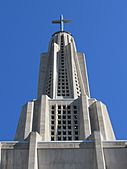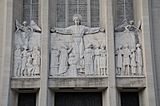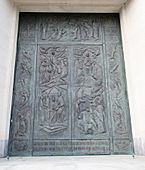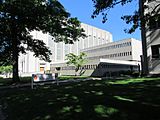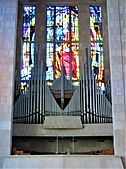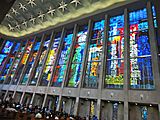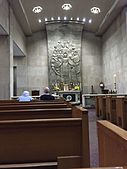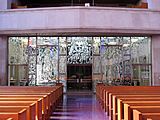Cathedral of St. Joseph (Hartford, Connecticut) facts for kids
Quick facts for kids Cathedral of St. Joseph |
|
|---|---|
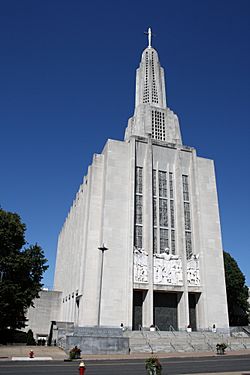 |
|
| 41°46′06″N 72°41′32″W / 41.7684°N 72.6922°W | |
| Location | 140 Farmington Ave. Hartford, Connecticut |
| Country | United States |
| Denomination | Roman Catholic Church |
| History | |
| Founded | 1872 |
| Consecrated | May 15, 1962 |
| Architecture | |
| Heritage designation | |
|
U.S. Historic district
Contributing property |
|
| Part of | Asylum Avenue District (ID79002672) |
| Added to NRHP | November 29, 1979 |
| Architect(s) | Eggers & Higgins |
| Completed | 1962 |
| Specifications | |
| Capacity | 1,750 |
| Length | 284 feet (87 m) |
| Width | 156 feet (48 m) |
| Height | 108 feet (33 m) |
| Number of spires | One |
| Spire height | 281 feet (86 m) |
| Materials | Concrete & Limestone |
| Bells | 12 |
| Administration | |
| Archdiocese | Hartford |
The Cathedral of St. Joseph in Hartford, Connecticut, United States, is a very important church. It is the main church for the Archdiocese of Hartford. This means it's where the Archbishop of Hartford leads services. The cathedral was officially opened on May 15, 1962. It was built on the same spot where an older cathedral once stood, which was sadly destroyed by a fire. You can find it on Farmington Avenue, just outside downtown Hartford.
In 1979, the cathedral became part of the Asylum Avenue District. This district is listed on the National Register of Historic Places, which means it's a special historical site.
Contents
History of the Cathedral
The states of Connecticut and Rhode Island became the Diocese of Hartford in 1843. This was decided by Pope Gregory XVI. At first, the bishop chose to live in Providence, Rhode Island. This was because more Catholic people lived there. The next two bishops also lived in Providence.
Building the First Cathedral
Bishop Francis Patrick McFarland wanted the diocese to be split. After the Diocese of Providence was created in 1872, Bishop McFarland moved to Hartford. He bought an old estate for $75,000. This land was for a cathedral, the bishop's home, and a motherhouse for the Sisters of Mercy. The convent was built first. Its chapel was used as a temporary main church, called a pro-cathedral.
Patrick Keely, an architect from Brooklyn, New York, was chosen to design the cathedral. Bishop Thomas Galberry laid the first stone on April 29, 1877. The basement of the church was ready for use the next year. Bishop Lawrence Stephen McMahon finished paying off the diocese's debts. This allowed the original St. Joseph's Cathedral to be completed. It was officially opened on May 8, 1892.
The first cathedral was built in the Gothic Revival style. It had a cross shape. Its outside walls were made of rough brownstone. Two towers, each about 150 feet (46 m) tall, stood at the front. Inside, the ceiling had wood from many countries. A round area had $100,000 worth of gold leaf. The bishop's special chair was carved from oak. There was also a marble altar and 72 stained glass windows. The church was decorated with paintings and statues.
In 1938–1939, the building needed repairs because of the soil. Sadly, a fire destroyed the cathedral on December 31, 1956. No one ever found out what caused the fire. Experts said the building could not be saved. So, the site was cleared.
Building the Current Cathedral
The architectural company Eggers & Higgins from New York City was chosen to design the new cathedral. On September 8, 1958, Archbishop Henry Joseph O'Brien led the groundbreaking ceremony. While the new church was being built, Sunday Masses were held in a nearby insurance company's auditorium. Daily Masses were held in the school auditorium.
Auxiliary Bishop John Francis Hackett blessed the lower church on Christmas Eve 1960. Archbishop O'Brien celebrated the first Mass there that night. Bishop Hackett laid the cornerstone for the main cathedral on October 3, 1961. The archbishop blessed the bells for the carillon in 1961. He also blessed the cross for the tower in 1962. Bishop Hackett officially opened the completed cathedral on May 15, 1962. It cost about $10 million to build.
In 2016, a new entrance was added, along with an elevator and restrooms. Two years later, the outside of the church was cleaned and fixed. This was because the limestone was starting to wear out. There are also plans to fix the front plaza. They want to create a "Cathedral Square" with a walking area, a park, and public gardens. The lower level of the cathedral might also be changed. It could become a place for learning, community meetings, dining, and a mausoleum.
On October 31, 2020, the cathedral held a special Mass. It was for the beatification of Rev. Michael J. McGivney. He started the Knights of Columbus group in 1882. Another ceremony happened at St. Mary's Church in New Haven, Connecticut. That's where McGivney used to work as a pastor.
Cathedral Architecture
The cathedral's design mixes modern International style with the tall look of Gothic buildings. It is made of strong concrete. This is covered with smooth, light gray limestone.
Exterior Features
Above the main entrance, there is a large carved picture, called a frieze. It shows Saint Joseph, who the church is named after. The tall bronze doors are very heavy, weighing five and a half tons. They have pictures of stories from the Bible. The cathedral stands very tall, reaching 284 feet (87 m) high. The stone blocks in the tall spire are cut in a special way. This makes light and shadows play on them all the time. The bell room has 12 bells. They were made in the Netherlands and weigh from 225 pounds (102 kg) to 3,850 pounds (1,750 kg).
Interior Features
The inside of the cathedral is famous for its huge, beautiful stained glass windows. They were made in Paris. They remind people of the windows in Paris' Sainte-Chapelle. Each window panel is about 70 by 14 feet (21.3 by 4.3 m) and 1 inch (2.5 cm) thick. Behind the altar, there is a large ceramic tile mural. It shows "Christ in Glory" and is the biggest of its kind in the world.
The entrance area, called the narthex, is separated from the main seating area, the nave, by a glass wall. This glass was etched by Giovanni Hajnal. It shows the Kingdom of Christ on Earth and in Heaven. The cathedral can hold about 1,750 people. This number does not include the two side chapels.
There are two main chapels on the sides of the church. One chapel has a special box for the Eucharist, called a tabernacle, and an altar. It also has a mural of Jesus and his followers. The chapel on the left has a mural of the Holy Family. It also has the baptismal font, where baptisms happen. Other smaller chapels are made of colorful mosaic tiles. They have kneelers for visitors to pray.
Pipe Organ
The pipe organ in the Cathedral of St. Joseph is the largest in Connecticut. The main organ is in the back gallery. It was designed by the Austin Organ Company, which is based in Hartford. This organ has four keyboards and many different sounds. It has 81 stops, 95 registers, 114 ranks, and 6,878 pipes!
There is also a smaller pipe organ in the Blessed Sacrament Chapel. This one was also built by the Austin Organ Company. It has three keyboards and 17 stops, 22 registers, 19 ranks, and 1,195 pipes. The organ is often used for many concerts.
Burials
- Lawrence Stephen McMahon, who was the Fifth Bishop of Hartford, is buried here.
Images for kids
- Interior
-
The nave
-
Stained Glass on the east wall
-
Blessed Sacrament Chapel
See also
 In Spanish: Catedral de San José (Hartford) para niños
In Spanish: Catedral de San José (Hartford) para niños




